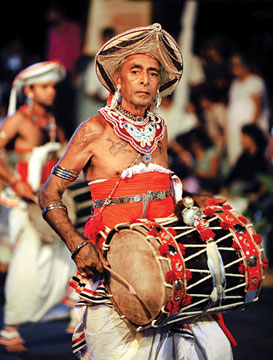|
Kandy Perahera:
Hill country’s dazzling pageant
By Pramod DE SILVA
| Perahera
schedule
August 10
Kapsituvima
August 10 to 14
Inside Perahera of the Four Devalas
August 15
First Kumbal Perahera
August 16
Second Kumbal Perahera
August 17
Third Kumbal Perahera
August 18
4th Kumbal Perahera
August 19
Fifth Kumbal Perahera
August 20
First Randoli Perahera
August 21
Second Randoli Perahera
August 22
Third Randoli Perahera
August 23
Fourth Randoli Perahera
August 24
Fifth Randoli Perahera |
As the rippling waters of the Kandy Lake reflect moonlight, the crisp
night air is punctuated by the sounds of rhythmic drumming. It can only
be the Kandy Perahera, that unique festival which has become a cultural
hallmark of Sri Lanka. Kandy is synonymous with the Kandy Esala Perahera,
which attracts thousands of visitors every year from Sri Lanka and
abroad.
 I
have been fortunate enough to witness the Perahera for a number of years
and my awe never diminishes, for this is a spectacle like no other. From
the caparisoned elephants to the elegantly clad Nilames to the hundreds
of colourfully dressed upcountry dancers, the Perahera never fails to
rekindle faith in the finest cultural traditions of our land. I
have been fortunate enough to witness the Perahera for a number of years
and my awe never diminishes, for this is a spectacle like no other. From
the caparisoned elephants to the elegantly clad Nilames to the hundreds
of colourfully dressed upcountry dancers, the Perahera never fails to
rekindle faith in the finest cultural traditions of our land.
Moreover, the commitment of all those who organise and participate in
this magnificent religious and cultural pageant, from the Diyawadana
Nilame downwards, is nothing short of astonishing.
This year’s Perahera will take place from August 10 to August 24,
Nikini Full Moon Poya Day. The Perahera will parade the streets in Kandy
town during this period and will culminate with a Day Perahera.
History
The festival, an annual homage to the Sacred Tooth Relic of the
Buddha enshrined in the Sri Dalada Maligawa, dates back to the glory
days of Anuradhapura, after the Sacred Tooth Relic was brought to Sri
Lanka in the year 310 AD by Prince Dantha and Princess Hemamala.
Sri Lankan kings had the responsibility of guarding the Sacred Tooth
Relic and whenever they shifted capitals, the Tooth Relic was also
relocated. The Tooth Relic found a permanent abode in Kandy, the last
Kingdom, where King Wimaladharmasuriya built the Sri Dalada Maligawa in
the 16th century.
The Perahera has been held in its present location since the reign of
Kirthi Sri Rajasinghe (1747-1781). The Main Viharas of Asgiriya and
Malwatte Chapters play a leading role in aspects connected to the
Perahera.
The highlight of the Perahera is the majestic Maligawa tusker
carrying the ‘Karanduwa’ containing the sacred relics, followed by a
large number of caparisoned elephants and dancers. This is the iconic
image we see in numerous illustrated depictions of the Perahera and one
which is always mesmerising. This and other aspects of the Perahera have
changed little over the centuries, as these are traditions that have
withstood the test of time.
The only thing that technology has perhaps changed is that people
around the world can see the Perahera in real time, on television and on
the Web. While nothing can equal ‘being there’ as the Perahera passes
just a few feet away from you, TV and the Web have enabled more people
to experience its wonders.
 Yet,
the proliferation of media coverage is not always healthy. Diyawadana
Nilame Nilanga Dela Bandara cites many instances when announcers used
wrong terms, in Sinhala and other languages, to describe certain parts
and aspects of the Perahera. He recently urged the media to refrain from
such practices and help the Sri Dalada Maligawa to preserve the finest
traditions of the Perahera for future generations. Yet,
the proliferation of media coverage is not always healthy. Diyawadana
Nilame Nilanga Dela Bandara cites many instances when announcers used
wrong terms, in Sinhala and other languages, to describe certain parts
and aspects of the Perahera. He recently urged the media to refrain from
such practices and help the Sri Dalada Maligawa to preserve the finest
traditions of the Perahera for future generations.
Just like other cultural traditions, the Kandy Perahera faces several
challenges. Domesticated elephants, especially tuskers are dwindling
while traditional arts and artistes are also slowly fading away. These
two factors have to be addressed in the medium-term to ensure the
success of not only the Kandy Esala Perahera, but also of other such
events.
Kap Situveema
The first tradition of the Perahera is the Kap Situveema where a
young tree is cut and planted in the compounds of the four Devalayas -
Natha, Vishnu, Kataragama and Pattini.
The main Perahera procession actually consists of five separate
Peraheras organised by the Sri Dalada Maligawa, Natha Devalaya, Maha
Vishnu Devalaya, Kataragama Devalaya and Pattini Devalaya and they take
part in the Perahera in that order.
The Randoli Perahera is the more magnificent of the two and if you
only have a day (or rather a night) to see the Perahera, it is advisable
to wait for the final night of the Randoli. (Randoli is derived from the
Sinhala term for palanquins used to carry royalty).
The Randoli Perahera is led by the Whip Crackers, who announce the
advent of the Perahera by cracking their whips.
The Peramunerala comes next, on the first elephant, carrying an Ola
manuscript called the Lekam Mitiya. The drummers are next, playing a
variety of drums. Next in line is the Gajanayaka Nilame. The
Kariyakorale, responsible for all the ceremonies of the Maligawa, walks
next.
The Maligawa Tusker, the most anticipated sight of the Perahera, then
comes along majestically. A canopy is held over the Tusker carrying the
Karanduwa and Paavada, a pure white cloth, is spread as the Tusker
progresses. The Karanduwa is placed on the Maligawa Tusker by the
Diyawadana Nilame.
Glamorous event
There are lines of dancers who follow the Tusker and it is then the
turn of the Diyawadana Nilame to walk by gracefully. The Peraheras of
the Devalayas then follow. It is a feast for the eyes right to the very
end, witnessed by thousands of pilgrims and tourists who line up on
either side of the Perahera route.
The end of the pageant is marked by the traditional ceremony of Diya
Kepeema, (water cutting) at the Mahaweli River at Getambe, just a few
kilometres from Kandy, along with the Day Perahera.
 A
traditional report on the successful conclusion of the Perahera was
presented to the King in the ancient days. This report is now presented
to the President at the President’s House in Kandy, where the artistes
who take part in the Perahera also receive commendations. A
traditional report on the successful conclusion of the Perahera was
presented to the King in the ancient days. This report is now presented
to the President at the President’s House in Kandy, where the artistes
who take part in the Perahera also receive commendations.
The Dalada Perahera has enthralled islanders and visitors for
centuries and it will continue to do so. The earliest record maintained
on the Dalada Perahera was by Chinese Pilgrim Monk Fa-Hien, who visited
Sri Lanka in the fifth century A.D.
“By the side of the King’s Palace is the Vihara of the Buddha’s
Tooth, several hundred feet high, brilliant with jewels and ornamented
with rare gems. Above the Vihara is placed an upright pole on which is
fixed a great padmaraja (ruby) jewel..... The Tooth of the Buddha was
always brought forth in the middle of the third month.
Ten days beforehand the king grandly caparisoned a large elephant on
which he mounted a man dressed in royal robes, who could speak
distinctly, and the man went round beating a large drum, describing the
life and the virtues of the Buddha, and announcing to the public;
‘Behold, 10days after this, Buddha’s Tooth will be brought forth, and
taken to the Abhayagiri Vihara.
Let all and each, whether monks or laymen, who wish to amass merit
for themselves, make the road smooth and in good condition, grandly
adorn lanes and byways, and provide abundant store of flowers and
incense to be used as offerings to it.”
Robert Knox, an Englishman who lived in the court of Kandy for many
years as a prisoner during the time of Rajasinha II (1636-1684) also
wrote about the Perahera. Writers will continue to express their awe of
the Perahera for centuries to come. Without any doubt, the Kandy
Perahera is one of the most famous and spectacular religious and
cultural festivals in the world. It is unrivalled and unparalleled for
the reverence with which it is conducted and the artistry associated
with it.It is an event that one should see at least once in a lifetime
and possibly more, for the wonders of the Kandy Perahera shall never
cease. Up close or on television, make sure that you witness the
Perahera this year, starting August 14. |

